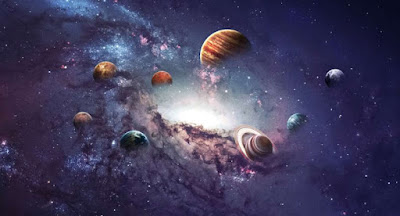This Buddhist creation myth BEATS Judeo-Christian Bible and Islam's Quran
1. The Buddhist perspective on cyclical cosmic evolution and devolution
2. How it challenges traditional creation narratives
3. The concept of Dependent Origination and its implications
4. Buddhism's unique approach to deities (devas, light beings, shining ones) and divine intervention
5. The Buddha's emphasis on personal experience over scriptural authority.
Gain insights into how this ancient wisdom offers a transformative view of human nature, societal structures, and our relationship with the cosmos.
A Buddhist Genesis?
 |
| Dharma...Evolution (Sugunasiri) |
SCIENCE MYTH 1: Once upon a time, before everything came into existence, this happened, then it came into existence in a spontaneous Big Bang.
What was that? - Just another Bang - Q: Well, how did that happen if there wasn't anything yet?
- A: Uh, umm, question does not compute, insufficient data, syntax error, program will now shut down for regularly scheduled maintenance.
- 4H MYTH: (Popular in the Dharmic religions). One day God (who spontaneously arose in the midst of a great void and nothingness) got bored so He made everything (maya) else to amuse Himself, and to keep it interesting and full of drama (lila) forgot it was just Him (because we're all Him or figments of His imagination in this illusion), so it's alright whatever happens, just a part of a big game with Hells and Heavens, Hierarchies and Holes in the story (so don't read too much into it).
CHRISTIAN MYTH: (Applicable to all of the Abrahamic faiths, i.e., Islam, Christianity, Judaism, Yazidism, Gnosticism, Bahai, and probably their progenitors Mithraism, Zoroastrianism, ancient Mesopotamian, Babylonian, and Sumerian religion). Once upon a time, God was bored in heaven, so He made a terrarium and populated it with all sorts of creatures and even a little man like Himself, in His own image, called him Adam, gave him a partner named Lilith, whom he later divorced and remarried another named Eve, and had a whale of a time creating other fantastical living beings to be in His garden, even a scaly man who was a big smartass and troublemaker, talking Eve into all kinds of mischief so that He had to empty out the project and toss the main characters to the east, which is how we all came about in this sucky world suffering from the cradle to the grave. Nighty night, no question, time for bed!
God animated dust with breath to create Adam. - Our Lady of La Salette Marian apparition (miracle)
 |
| Ooh, let's land on that blue-green one! It looks nice and inviting, and we can b*ng there. |
 |
| We revolve in a cycle until liberation. |
- BUDDHIST MYTH: Once upon a time, in a land near, near this way, two light beings (or beams) alighted on this preexisting celestial body we call Earth, a garden like place, after flying in space and going about in their refined way. They liked it and stayed, and in so doing, they became coarser and coarser, devolving from their previous state.
- The beings were engaging in gathering, eating, tasting, and sensual experiences like sex, experiencing the results (vipaka and phala) of their collective deeds (karma), which had a profound impact on their environment, being reborn over and over, until we find ourselves in our present state with people not realizing that the things they say and do had a previous meaning they've forgotten. And that, monks, is how things in the present are like things in the past, and it's always a good idea to keep good conduct, be pure, and evolve back to that Golden Age of Truth (Satya Yuga) when things will be better before eventually, invariably, decline again and devolve in this spiraling cyclical pattern we call samsara.
- Q: That's a "creation" myth?
- A: No, where in the sutra does it say anything about "creation"? This is just a story about how humanoid life began on this planet/plane, devolving from a higher plane by the workings of karma.
SCIENCE MYTH 2: Once upon a time everything declined and collapsed falling in on itself then there was a Big Bounce and it re-expanded until we find ourselves and our universe expanding again as evidenced by the Doppler Effect of the redshift of visible light and there's no discernible beginning or end to it, just like the Buddha taught.
This is how it happened, according to math. - In science, anything is possible: Physicists turn light into one-dimensional gas with incredibly strange properties (IFL Science) The Big Bang is utterly dumb as a theory of everything because it says there is no need for miracles except this one. Just grant that everything came out of nothing in a nano-instant then everything else we explain will be rational, lawful (in accordance with demonstrable principles), and predictable.
- Maya Wisdom (video), Sept. 3, 2024; Dhr. Seven, Pat Macpherson, Sheldon S. (eds.), Wisdom Quarterly
 |
| Yay for Aldebaran! (Maria Orsic) |



















































































































































































































































No comments:
Post a Comment